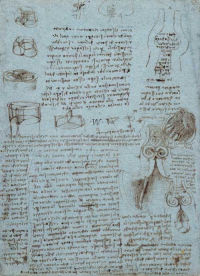The Body of Man Click on the thumbnails to explore the trail
Read more about this trail (expand)
According to Leonardo, man himself was at the centre of everything– “The measure of all things”. Throughout his life, the artist engaged in a dynamic and increasingly in-depth examination of man as a living organism, embarking on a seemingly unending quest to discover how man moved, grew, developed and perceived the world in which he lived.

- Enlarge
- Zoom & explore
- The Royal Collection © 2005, Her Majesty Queen Elizabeth II
Notes on the valves of the heart and flow of blood within it, with illustrative drawings c1513
During the final years of his life, Leonardo carried out detailed investigations of the heart. The main aim was to define how the heart and its valves operated in conjunction with the hydrodynamic turbulence of pumped blood.
Leonardo noted how vortices are formed in the blood after it has forced its way between the cusps, as a result of the contraction of the heart. Based on his observations of the flow of water, he proposed a complex theory regarding how and why vortices form. Despite being forced to concede that the complexities are “subtle and difficult to prove or clarify”, he deduced that the principles of circular motion in fluids are essential to the operation of the heart. He noted that the cusps of the valve only operate satisfactorily because of the vortices that form in the blood, which cause the closure of the valve. Without the circular motion, the inner walls of the valve would simply collapse.
The drawing on the upper right illustrates a mould from which a glass model of the neck of the aorta might be made in order to test his theory.
In Leonardo's words
The interval between two beats of the pulse is half of a musical tempo. Between one and the next beat of the pulse the heart closes twice and opens once, and between one and the next opening the heart opens twice and closes once…Accordingly, in every harmonic tempo, the heart has three motions.
This sheet is one of a series of studies that document the detailed investigations of the heart and lungs conducted by Leonardo during the last years of his life.
The studies and notes on this sheet relate to the valves of the heart, their structure and the flow of blood within them. Leonardo is particularly interested here in the geometric structure of the aortic valve.
The drawing on the upper right illustrates a mould for the making of a glass model of the pulmonary or aortic valve, which Leonardo planned to make. A reference to the construction of a glass model of the heart is found on another sheet also at Windsor, dated 1513.
- Medium Pen and ink on blue paper
- Size 28.3 x 20.7 cm
- Location The Royal Collection










